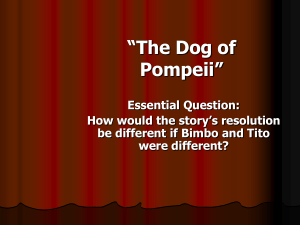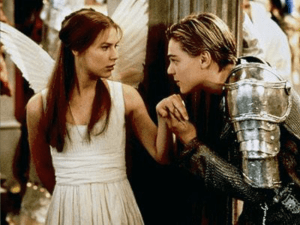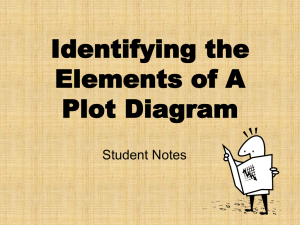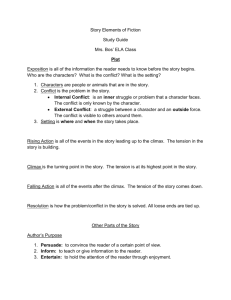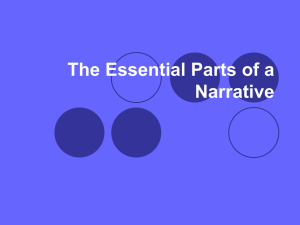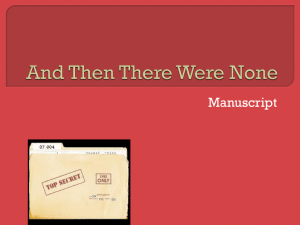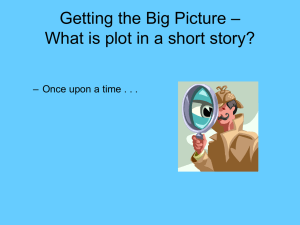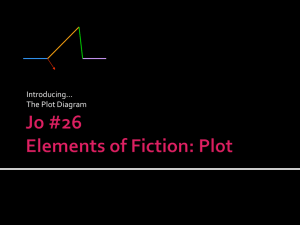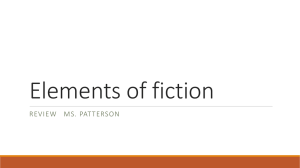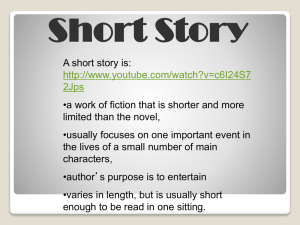Characters - MrFranta.org
advertisement
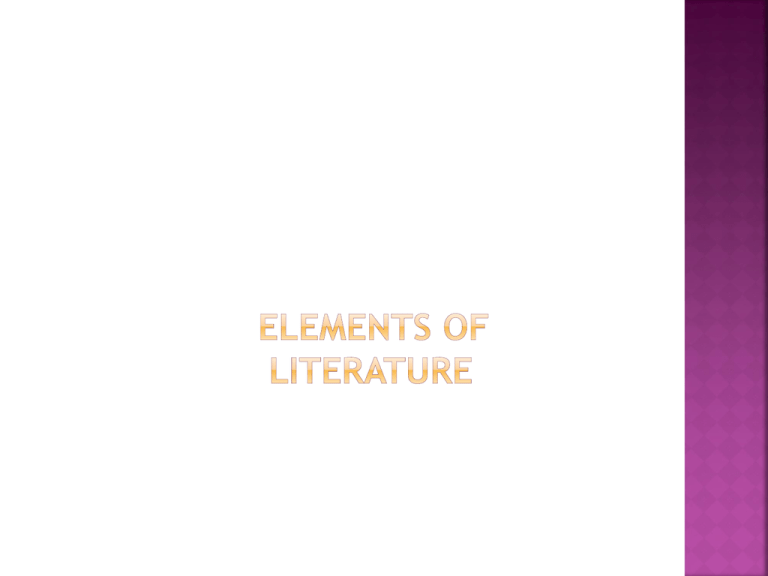
Setting Characters Conflict Plot Point of View Tone Mood Theme Where it takes place When it takes place—time of day, season, era We left the home place behind, mile by slow mile, heading To create a mood or for the mountains, across the prairie atmosphere where the wind blew forever. At first there were four of us To show a reader a one horse wagon and its skimpy different way of life with load. Pa and I walked, because I was a big boy of eleven. My two To make action little sisters romped and trotted seem more real until they got tired and had to be boosted up to the wagon bed. To be the source of That was no covered conflict or struggle Conestoga, like Pa’s folks came West To symbolize an idea in, but just an old farm wagon, drawn by one weary horse, creaking and rumbling westward to the mountains, toward the little woods town where Pa thought he had an old uncle who owned a little two-bit sawmill. Taken from “The Day the Sun Came Out” by D. Johnson Characters are the people in the story. A writer reveals what a character is like and how the character changes throughout the story. Two primary methods of characterization: Direct- writer tells what the character is like ex. He is tall. Indirect- when the reader infers character traits ex. He had to duck to enter through the door, so his head wouldn’t hit the doorjam. …And I don’t play the dozens or believe in standing around with somebody in my face doing a lot of talking. I much rather just knock you down and take my chances even if I’m a little girl with skinny arms and a squeaky voice, which is how I got the name Squeaky. From “Raymond’s Run” by T. Bambara The old man bowed to all of us in the room. Then he removed his hat and gloves, slowly and carefully. Chaplin once did that in a picture, in a bank--he was the janitor. From “Gentleman of Rio en Medio” by J. Sedillo A writer reveals what a character is like and how the character changes throughout the story. Four primary types of character: Flat- reveals only one or two traits. Round- reveals varied and sometimes contradictory traits. Static- Do not change Dynamic- Change throughout the story to gain a higher understanding of life. Are one dimensional. Good guy =Hero Have many sides to them; complex Many traits Never change Change during the story Main character Emotions are temporary. Emotions are feelings, reactions to situations and people. Happy, sad, frustrated, jealous, tired etc. Traits are permanent. Traits are physical and personality. One’s trait can dictate their emotions. Tall, intelligent, resourceful, volatile, negative, wacky, daring, impulsive, cautious etc. Name the four types of characters Superman Flat Santa Professor Snape Static Types of Characters Dynamic Edward, Bella Round Fall into one of these three categories… Protagonist Antagonist Foil Main character Opposition Protagonist of Character who provides contrast to Protagonist Physical appearance of character Personality Background/personal history Motivation Relationships Conflict Does character change? Sequence of events Give Structure Exposition Rising Action Climax Falling Action Resolution Beginning of the story “Once upon a time” Introduced to characters, setting and major conflict Sets up conflict Builds tension Turning point Major shift/change occurs Helps to show the theme Wrapping up story Immediately after climax Point of closure Ending Theme is often stated Where does each part fit? A. Rising Action B. Falling Action C. Climax D. Exposition A. Rising Action B. Exposition C. Climax D. Falling Action A. Climax B. Ending C. Beginning D. Builds tension A. Falling action B. Climax C. Rising Action D. Exposition Conflict a fight. is more than just Two humans in confrontation Internal conflict, struggle Facing the elements or animals Going against social norms Central concept Author’s observation Vantage text point of the As if you are telling a story I, me, my Story told from an observer See, Hear He, she, her, him Sees into the mind of a character Told by a person who knows everything about everyone in the story. Hints or clues on what’s to come Contrast between what appears true and what really is. Verbal Situational Dramatic What is said vs. what is meant Something surprising occurs; opposite of what’s expected Reader knows something the characters don’t know Author’s attitude toward a subject Author’s attitude Pessimism Optimism Bitterness Joyful Humorous Earnestness * The feeling or climate of a story, as felt by the reader Setting Objects Details Images Words Influence the Mood Language that goes beyond literal meaning comparison as of two unlike things using like or Implied comparison of two things “Juliet is the sun” Exaggerated terms “I read it a million times!” Words that mimic sounds BANG! POW! Reference to literature, history or art Helps the reader to make connections to form a deeper understanding. They are like Romeo and Juliet. Like Cain did Able. Repeated initial sound: Peter Piper picked a peck of pickled peppers Giving inanimate objects human traits. What can people do that things cannot? Think, laugh, breathe, sigh, yawn, giggle, scream, yell, retort, flirt… The butterfly flirted with the flower. A symbol is when an object, color, number or name represents another idea; symbols help us to figure out the theme.
